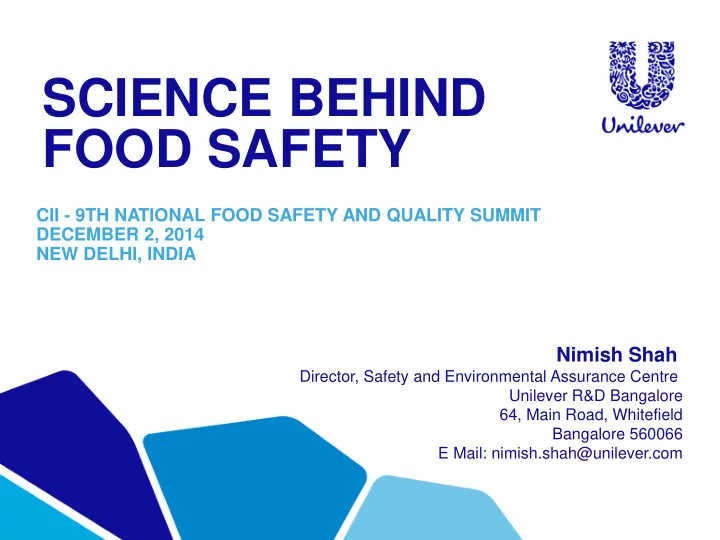

SCIENCE BEHIND FOOD SAFETY CII - 9TH NATIONAL FOOD SAFETY AND QUALITY SUMMIT DECEMBER 2, 2014 NEW DELHI, INDIA Nimish Shah Director, Safety and Environmental Assurance Centre Unilever R&D Bangalore 64, Main Road, Whitefield Bangalore 560066 E Mail: nimish.shah@unilever.com
OUTLINE • Pathogens and their health impact • Risk Assessment – Applying science to determine safety thresholds • Knowledge and expert tools • Surveillance and public health • Food safety expertise
FOOD ANALYSIS: SPEED AND SENSITIVITY PCR/ Antibody based tests allow detection of single/ very few numbers of pathogens in matter of minutes-hours
FOOD-BORNE PATHOGENS & HEALTH IMPACT Micro-organism* Illnesses (%) Hospital. (%) Death (%) 0.198 0.014 0 Bacillus cereus 1.3 2.9 0.107 Staph. aureus Yersinia enterocolitica 0.628 1.8 0.126 Cl. botulinum 0.00042 0.076 0.246 1.8 0.064 0.360 Cl. perfringens 0.038 0.203 1.7 Vibrio E. coli (path.) 1.3 4.6 4.3 Campylobacter 14.2 17.3 5.7 0.018 3.8 27.5 L. monocytogenes 9.7 25.7 30.4 Salmonella SEAC *Infectious dose varies from pathogen to pathogen
EXAMPLE 1 - DETERMINING SAFETY THRESHOLD Chamomile Infusion (similar to tea) No microbiological standards Bacillus species found up to 1000 CFU/ ml Bacillus spp . are common in a wide range of environments and raw materials (also in many processed foods) Bacillus cereus , well established as a cause of food- borne illness in humans, could also be present sometimes This pathogen may not be inactivated by the hot water used for infusion making Question – What is the risk to the consumer drinking the infusion? SEAC
EXAMPLE 1 - DETERMINING SAFETY THRESHOLD Samples in consumer trial contained maximum levels of 3 x10 3 cfu/ml Immediate consumption - levels will not change Large numbers of B. cereus are required to cause food poisoning Numbers found in foods implicated in B. cereus food poisoning are typically within the range of 10 5 to 10 9 cfu/g or ml In outbreaks associated with these organisms, levels were always above 10 6 /g The health risk to consumers is considered negligible and acceptable at levels <1000/g SEAC
EXAMPLE 2 - MANUFACTURING ASPECTS B. cereus D-values at 90C Raw material contamination 1.2 0.6 1 Density of Probability Density of Probability 0.8 0.4 0.6 0.2 0.4 0.2 0 0 0 0.5 1 1.5 2 2.5 3 3.5 4 -0.5 0 0.5 1 1.5 2 2.5 Bacterial concentration (log cfu/g) D-values (log min) Variability in heat impact Variability in spore levels in ingredients Variability in spore heat resistance Number of surviving spores in contaminated packs Number of surviving spores in contaminated packs 0.3 0.25 Density of Probability 0.2 Only 50% of packs contaminated 0.15 0.1 0.05 0 1 3 5 7 9 11 Number of Spores surviving the HT (cfu/g) J.-M. Membré, A. Amézquita, J. Bassett, P. Giavedoni, C. de W. Blackburn, L.G.M. Gorris. (2006) J. Food Prot. , 69 : 118-129.
Example 3 - Listeria Monocytogenes Influence of microbial limit on incidence % “detective” % “defective” Predicted no. of listeriosis cases * when: servings servings absent in 25 g < 100/g 0 0.002 0.02 0.00001 0.006 0.025 0.0001 0.04 0.061 0.001 0.42 0.44 0.01 4.23 4.25 0.1 42.3 42.3 1 419 419 “Defective” servings assumed to contain ≥ 10 6 L.m./g * In the USA per Mill population No increase in predicted disease outcomes despite relaxing pathogen limit Source: FAO/WHO Listeria monocytogenes risk assessment
QUANTIFYING RISKS - MODELING ppm/ ppb Serving size
SCIENTIFIC TOOLS
SURVEILLANCE OF FOOD-BORNE ILLNESS: EXAMPLE 1 – CDC (USA) http://www.cdc.gov/foodnet/data/trends/tables/2013/table2a-b.html#table-2b
SURVEILLANCE OF FOOD-BORNE ILLNESS: EXAMPLE 2 – AUSTRALIA http://www.health.gov.au/internet/main/publishing.nsf/Content/cda-cdi3603-pdf-cnt.htm/$FILE/cdi3603a.pdf
SURVEILLANCE OF FOOD-BORNE ILLNESS: INSIGHTS ON COSTS & BENEFITS http://www.food.gov.uk/sites/default/files/multimedia/pdfs/fds2015.pdf
SEVERAL FOOD R&D INSTITUTIONS: FOCUS ON FOOD SAFETY INADEQUATE (?)
Science Based Food Safety: A National Priority Establishment of FSSAI – a key milestone for the country Recommendations: • Evolve a modern science-based food safety system • Strengthen health surveillance systems • Robust assessment of health issues linked to foods • Build global capabilities – resources, expertise and infrastructure Risk Assessment , Management and Communication Capabilities & Mindset Collaboration and Networking National & International – consider instituting a national food safety network
Acknowledgements: Paul Hepburn & Alejandro Amezquita THANK YOU
Recommend
More recommend